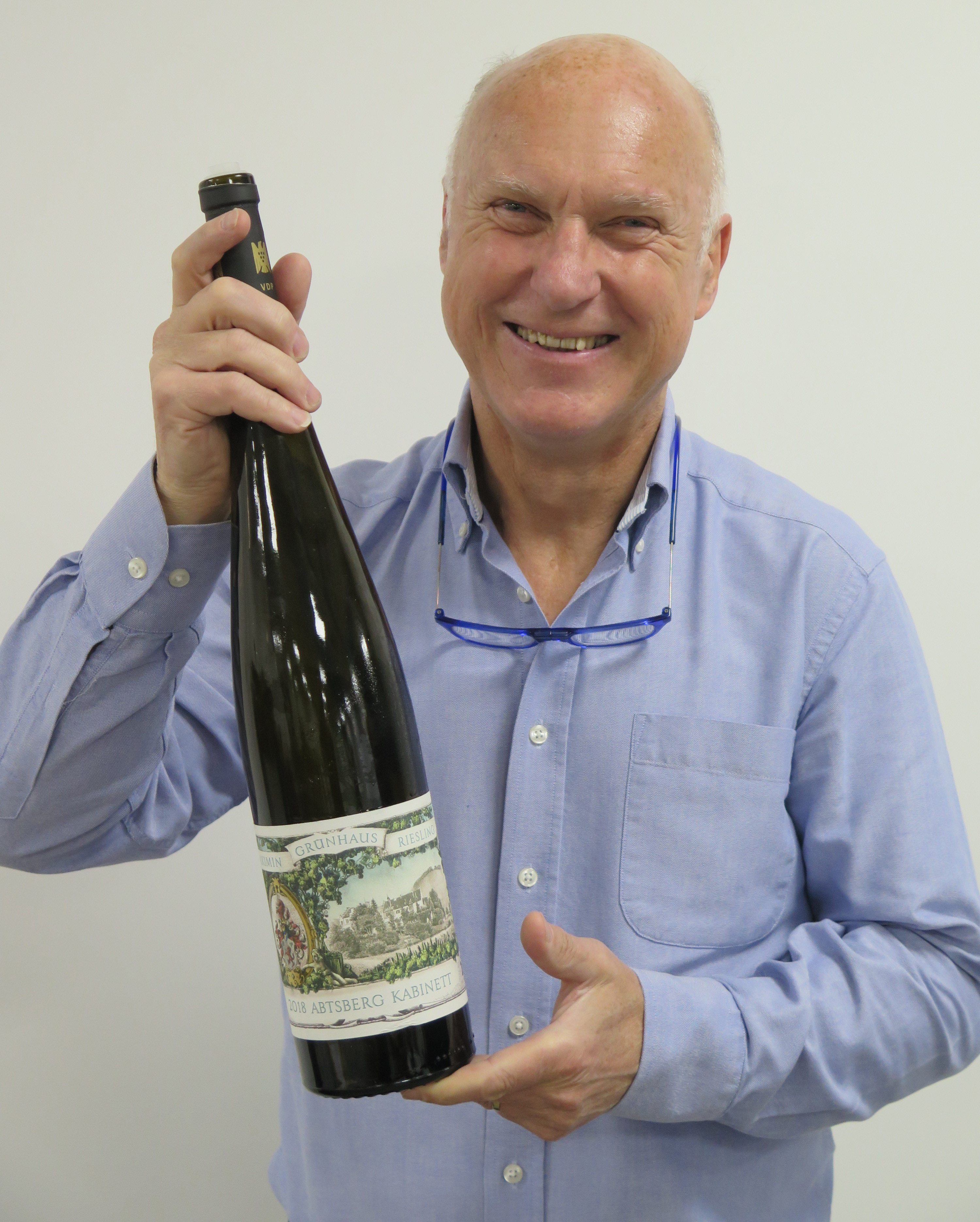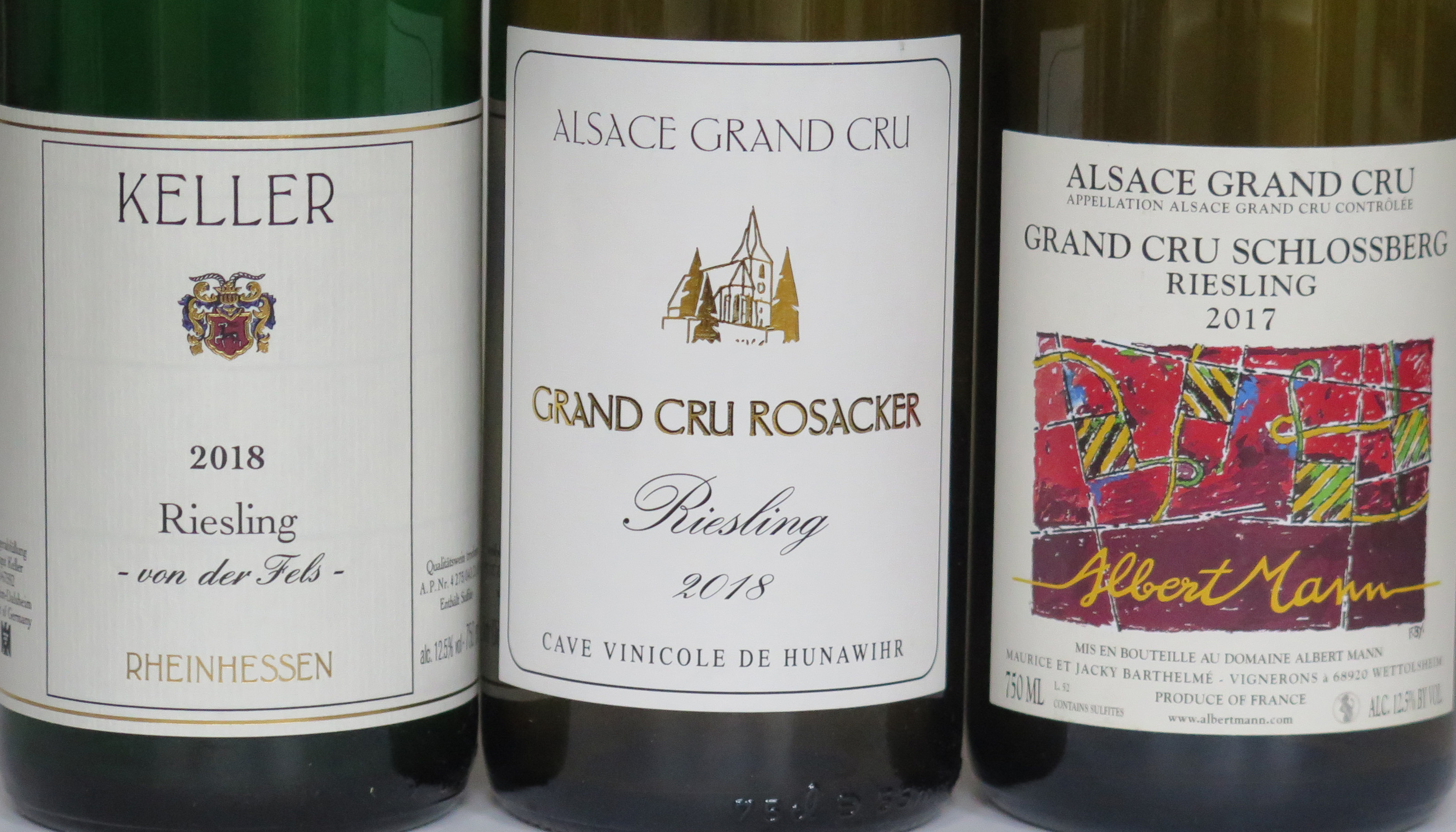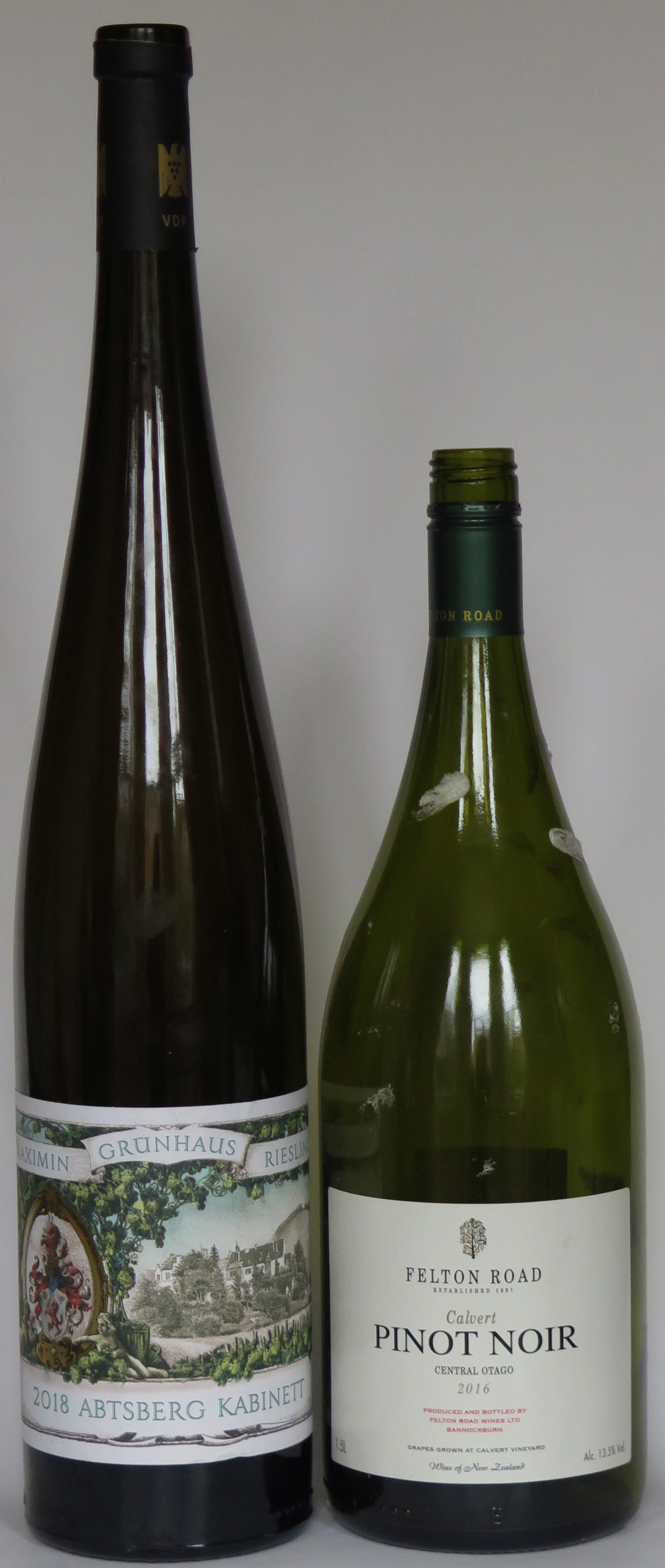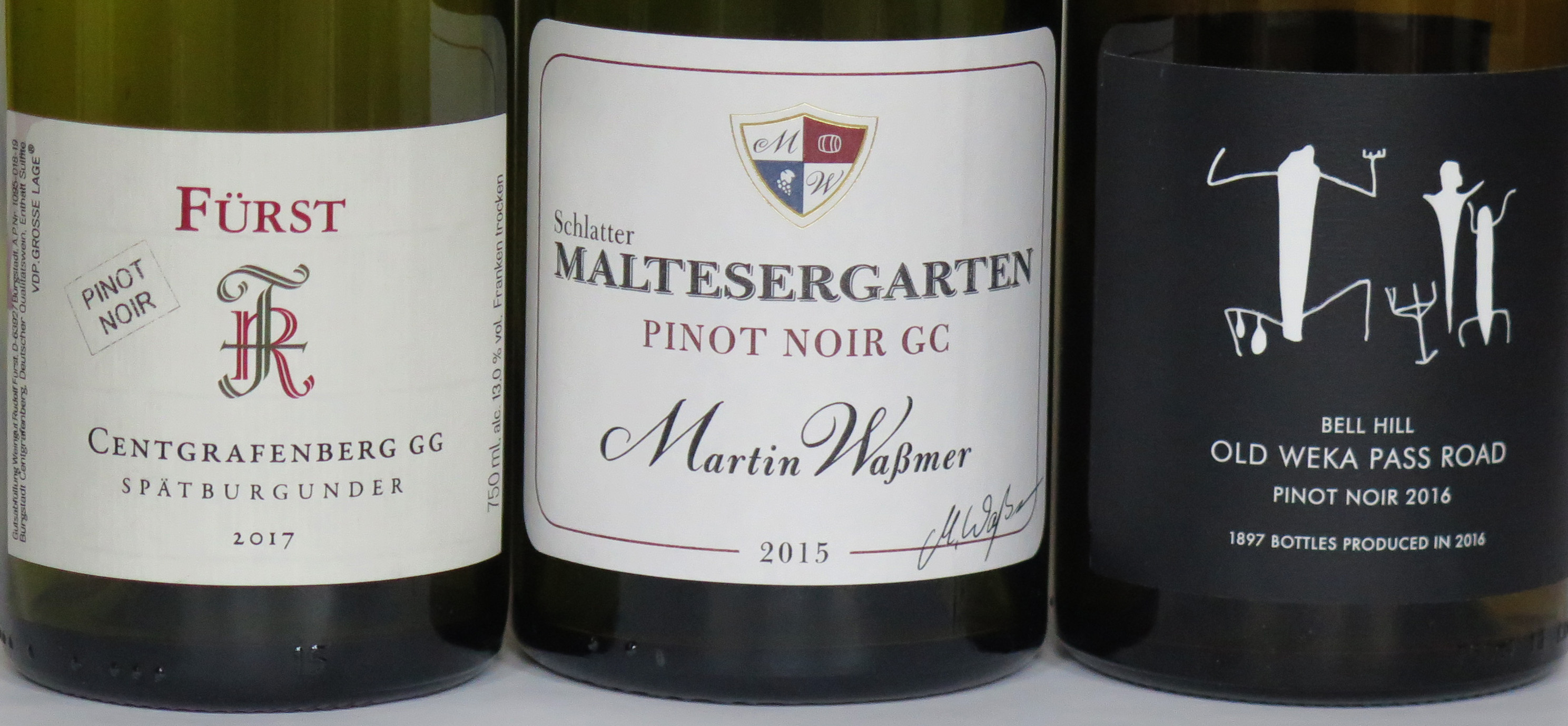Well known to the Club and a stalwart of the ‘Call my Bluff’ evenings, Richard Bampfield introduced the tasting by  confessing that for long periods he had not tasted Rieslings, indeed to such an extent that when he led a visit to Alsace some years ago, one attendee commented that Richard did not know much about the wine! However, in the intervening years he had begun to appreciate greatly the qualities of Riesling and Pinot Noir, in their differing expressions. Richard had recently visited both the Mosel and New Zealand, so his interest in and enthusiasm for these areas directed his selections for the tasting.
confessing that for long periods he had not tasted Rieslings, indeed to such an extent that when he led a visit to Alsace some years ago, one attendee commented that Richard did not know much about the wine! However, in the intervening years he had begun to appreciate greatly the qualities of Riesling and Pinot Noir, in their differing expressions. Richard had recently visited both the Mosel and New Zealand, so his interest in and enthusiasm for these areas directed his selections for the tasting.
The tasting was structured to show the differing aspects of Riesling and Pinot Noir and how they will reflect the terroir, if the winemakers allow the grapes to do so. Richard commented that Riesling is the wine that ‘professionals drink and no one else understands’!
1. Riesling Grand Cru Rosacker 2018, Cave Vinicole de Hanawihr 13%, Alsace France £21.99 NY Wines
The wine is produced in the heart of Grand Cru Alsace, where the soil is higher in limestone, which produces a lighter and more delicate, yet intensely flavoured, wine.
Produced by a cooperative, Richard commented on the relative recency of the structure of the wine trade in Alsace and that many French wines are still made to the highest standards using the co-operative system.
Grand Cru Rieslings can age for many years; however, this wine is drinking well in its youth, which is possibly the intent of the winemaker. Additionally, climate change means that greater ripeness is being achieved and therefore wines in general are maturing earlier. The vineyard from which the wine is produced covers 26 hectares, half of which is planted with Riesling vines.
Pale lemon yellow in colour, on the nose delicate floral aromas, some peach, pear and stone fruits were noted.
On the palate, there was a good balance between acidity and sugar, however it was difficult to pinpoint the wine as being either dry or off dry. It was noted that the terms sweet or dry are not present on the labels and Richard commented that there is a difference in attitude between the French and British consumers, with the British more concerned with sweetness levels when it comes to food and wine matching. The French are more relaxed and tend towards possibly enjoying a sweeter wine with for example chicken. A scale of 1-4 is sometimes used for Alsace wines, from dry to sweet. This wine has 8g of residual sugar, so is a 1 on the scale. The wine has good length, with a slightly honied after taste.
 2. Riesling Grand Cru Schlossberg 2017, Domaine Albert Mann, 12.5%, Alsace, France £58
2. Riesling Grand Cru Schlossberg 2017, Domaine Albert Mann, 12.5%, Alsace, France £58
Richard commented that Albert Mann is considered something of a ‘superstar’ of Alsatian wine making and was the wine producer of the year in the Revue des Vins de France several years ago. Not all of his wines are produced to this relatively high price point. Schlossberg is considered to be one of the great Crus and the wine is grown on a steep heavily terraced hillside, so not much mechanisation is possible. The soil is granite and the vineyard covers 80 hectares.
In appearance, darker in colour than Wine 1, verging into light gold.
On the nose, stone fruits again, but more complex than the Rosacker with a slight spiciness, possibly a mustiness or more earthy aromas. Richard commented that the nose was typical of an older, more mature wine.
The producer uses natural yeasts and has been biodynamic since 1997.
In general Alsace wine making is considered to be less interventionist than in other areas, for example, although the wines are aged in oak, it is not in order to impart an ‘oakiness’ to the flavour, it is simply to impart some age. It was noted that Alsace is one of the sunniest areas of France and there is less rot and disease pressure due to the climate.
On the palate, the flavour profile was more intense than Wine 1, with more grip and an almost tannic expression. With 7-8g of residual sugar, the wine is dry and well balanced and has a warmth on the finish that belies its relative low alcohol content. Richard commented he had expected the wine to be tighter and tougher, given its relative youth.
Richard summed up Alsatian wine making by saying they love it when the have Australian visitors, because they can tell them Alsace wine makers have what they do not – 400 years of making mistakes!
It had originally been planned to taste the red wines before the white – explaining his rationale, Richard told us that in Burgundy, it is often the case that red wines are tasted before whites, since frequently the whites are richer than the reds and have more middle palate. Switching from reds to whites, he suggested, refreshes the palate and the brain. However, on tasting the wines on the night, Richard changed his mind and reverted to white before red, due to their individual profiles.
Moving on to the German Rieslings, Richard observed that in general the British do not appreciate top German wines and that in general the wines go to other markets. However, sales are slowly growing, albeit from a very low base.
3. Riesling von der Fels 2018, Weingut Keller, 12.5%, Rheinhessen, Germany £23 Howard Ripley Wines
A family estate, whose wines are highly valued. It is said that their wines ‘beat to no ordinary drum’. The Keller G-Max Riesling Trocken is only sold as part of a mixed case and its estimated per bottle price is around £2,000. Both Robert Parker and Jancis Robinson consistently give the G-Max over 95 points. The von der Fels is their entry level wine.
Discussing German Rieslings, Richard explained that wines that are labelled Fein Herb (or feinherb) are off dry and that this unregulated labelling gives more latitude to the winemaker. In general, German wine laws have not kept pace with climate change and as a result labels are confusing, since so many differing terms are used. More dry wines are now made in Germany than previously and German dry whites tend to be more reductive than elsewhere, with a greater preponderance of screwcaps than in most areas.
2018 was in general a warm and dry vintage in Rheinhessen, but this estate lost about 30% of their grapes due to a late hailstorm.
In colour, Wine 3 was about the same as Wine 2, but on the nose it showed some citrus and mint. On the palate it was tight, with mouth- watering, even aggressive, acidity.
In general, it was felt Wine 3 was less harmonious than Wine 1 and slightly disappointing although Richard felt might age better due to its strong core, for up to perhaps 5 years. In terms of food matching, it might perhaps suit a creamy fish dish.
Contrasting German Rieslings with those from Australia, Richard noted that in the past it was common practice for Australian producers to add acid to their lower priced Rieslings due to the ripeness of the grapes. However today the quality of the wines has improved. Adding acid can be un-noticeable if done well, rather like chaptalisation in Burgundy.
 4. Riesling Abtsberg Kabinett 2018 Weingut Maximin Grünhaus 8% Mosel, German £44 (magnum)
4. Riesling Abtsberg Kabinett 2018 Weingut Maximin Grünhaus 8% Mosel, German £44 (magnum)
Mosel wines are noted for their lightness and many have a slight petillance. Maxim Grünhaus is one of Richard’s favourite producers. The family’s lineage includes the composer Schubert.
Wine 4 was served decanted from the magnum and despite this showed a distinct smell of reduction which faded slightly as the wine sat in the glass. This aroma could be due to the sulphur content of the wine. The nose should be one of fruit, flowers and mint. Germans describe this sort of reductive wine as ‘sponti’ and claim the effect is a result of using wild yeasts and a resulting spontaneous fermentation. Reduction is often linked to the use of screwcaps, with producers choosing screw caps with differing oxygen transmission rates (OTRs). However, it can also be present in wines with traditional corks and is distinct from the effect of trichloroanisole (TCA).
On the palate, there was a distinct sweetness (c40g) but with balancing acidity and a distinct minerality. The flavour profile was of stone fruits, pears and apples in particular. For food and wine pairing, roast pork and roast chicken were suggested.
The use of the term ‘petrol’ in relation to the Riesling nose was discussed. It is believed this type of nose is a viticultural issue, related to the over-shading of the fruit on the vine. In Australia, canopy management is used to shade the fruit during the hottest part of the day, along with the orientation of the rows.
Introducing the following two German Pinot Noirs, Richard stated that good German Pinot Noir is generally more perfumed than the Burgundian wines and there is a tendency for them to have a more vegetal character which has been lost in Burgundy due to the effects of global warming.
 5. Spätburgunder Centgrafenberg GG 2017 Rudolf Fürst 13% Baden, Germany £75 Justerini & Brooks
5. Spätburgunder Centgrafenberg GG 2017 Rudolf Fürst 13% Baden, Germany £75 Justerini & Brooks
The Fürst vineyards are in the north-west of Franken, on light sandstone soil. The climate here is cooler than that of the area where Wine 6 is grown.
On the nose it was described as ‘huge’ and could be mistaken for a New Zealand Pinot Noir due to its character. Expressive, beautifully perfumed and with a slight hint of oak.
Appearance-wise, one writer has described this wine as having ‘an ethereal transparency’ (Anne Krebiehl MW, The Wines of Germany).
On the palate, forest fruits, some savoury notes, fresh, with soft tannins and with good length.
Although this is not Fürst’s top wine, it should cellar well due to its structure.
6. Pinot Noir Schlatter Maltesergarten GC 2015 Martin Wassmer 13.5%, Baden, Germany £49.50 The Wine Society
From a more southerly vineyard, this wine was described as a more traditional Spätburgunder. Made by one of two brothers who operate from the same village, the area in which the vineyards are located is more varied agriculturally, with asparagus and strawberries also being produced. Martin’s brother is considered to make bolder, more powerful wines. The soil is clay and loam.
The 2015 vintage was warmer than the 2017 and this combined with the more southerly location was evident on the nose and palate.
On both the nose and palate, Wine 6 had more raspberries and dark cherries as opposed to the more strawberry-like character of Wine 5. The tannins were more pronounced, and it was generally more complex and fresher than Wine 5, with a pronounced middle palate. The tannins were perhaps due to a greater use of oak than with Wine 5.
7. Pinot Noir 2016 Bell Hill Old Weka Pass Road 13%, Waikari, North Canterbury, New Zealand £65, Hedonism
From the area north of Christchurch where the climate is much cooler and windier, with a higher rainfall than in Otago. The Pegasus Bay Winery is not too far away, and Pyramid Valley lies to the west. The vines from which this wine is made are quite young, grown on a soil which contains a percentage of limestone. 66% new French oak is used, with a light char. This is the second wine of the producer.
Pale in colour for a Pinot Noir, on the nose and palate there are hints of green pepper. Overall the wine had a savoury, herbal quality with some slight smokiness, indicative of fruit that is not fully ripe.
Richard described this wine as ‘the antithesis of what one might expect from the Southern Hemisphere’.
8. Pinot Noir 2016 Felton Road Calvert Vineyard 13.5% Central Otago, New Zealand £88 (magnum)
Felton Road, based in Bannockburn to the south of the lake, has been biodynamic more or less since its inception. Other labels from this producer include Cornish Point and Bannockburn, the latter being a blend from various vineyards.
Climatically, Central Otago is an area of extremes – it can be very hot during the day and cold at night. Big differences occur in the yield between vintages due to the extremes of climate. The climatic conditions result in Pinot Noir berries that are rather thick skinned. Apricots and cherries were previously the main crops grown in the Cromwell area.
The vineyards on each side of the lake have very different soils, indeed Central Otago has a wide variety of soil types. There are numerous small producers in the area, which makes it difficult to achieve economies of scale.
Rather deeper in colour than Wine 7, on the nose the Felton Road had more primary aromas, whilst on the palate it was more structured and ‘warmer’ with more evident alcohol. Lots of ripe red fruits but did not perhaps deliver the length and complexity that could have been expected from a producer of Felton Road’s reputation.
Longer-serving members may remember Nigel Greening of Felton Road’s visit to the Club.
HRE 26.1.20